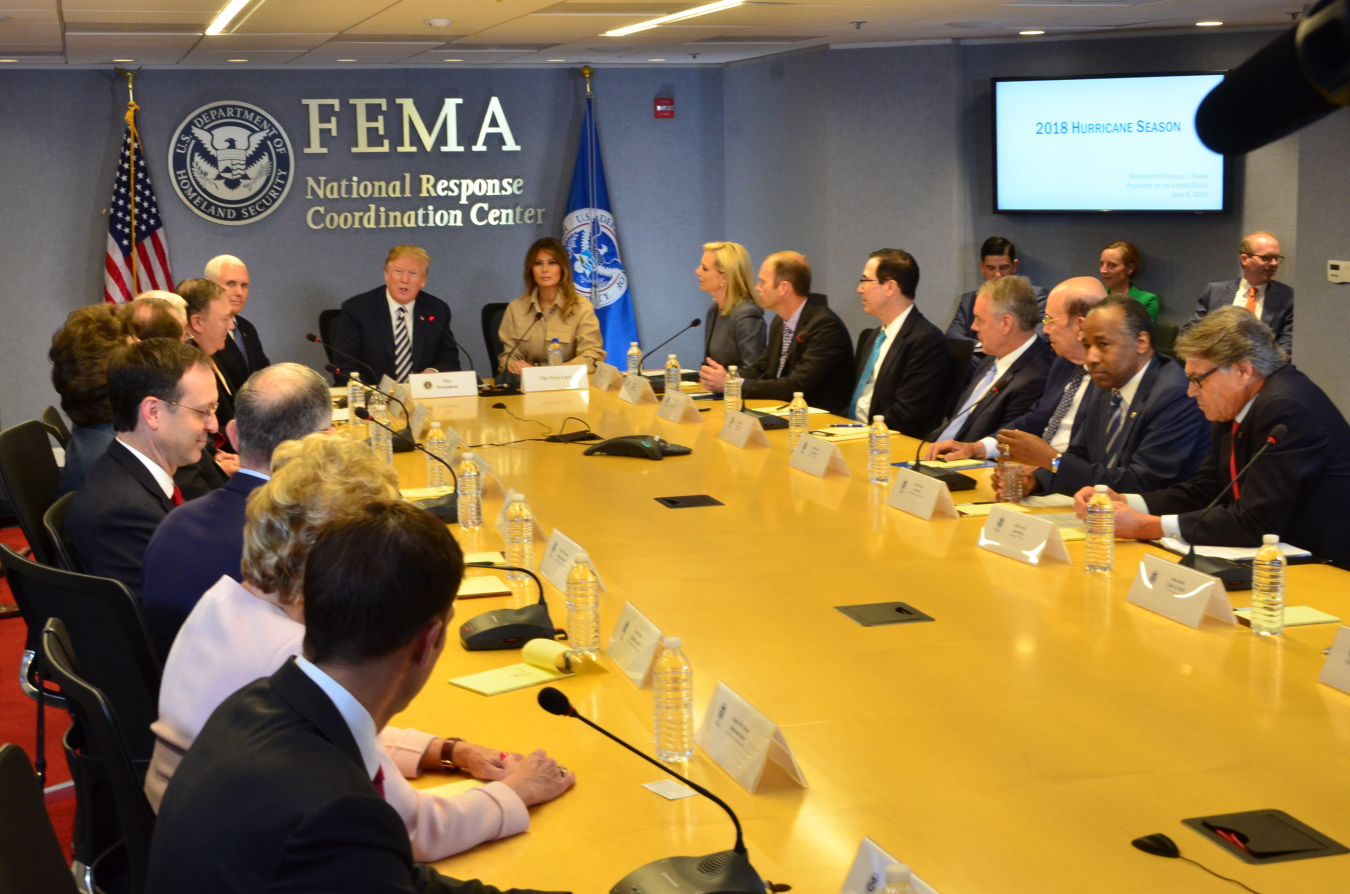The Federal government works closely every year with industry and government partners to prepare for hurricane season which begins on June 1.
Office of Cybersecurity, Energy Security, and Emergency Response
June 11, 2018Hurricane season in the Atlantic began on June 1 and will last through November 30. Every year, the Federal government works closely with industry and government partners to prepare for the season. If a major electricity outage or energy supply disruption were to occur as a result of a hurricane, we at the Department of Energy (DOE) would play a vital role in coordinating with our partners to prepare for and recover from such an event.
Energy Secretary Rick Perry joined President Trump, the First Lady, Vice President Pence, Homeland Security Secretary Nielsen and other officials in a hurricane briefing at the Federal Emergency Management Agency’s (FEMA) Headquarters. Below is a photo from the briefing.

DOE recently created a new office focused on protecting critical energy infrastructure and coordinating preparedness and response to natural and man-made threats. The Office of Cybersecurity, Energy Security and Emergency Response (CESER) leads DOE in its role as the Federal Sector-Specific Agency (SSA) supporting Emergency Support Function 12 (ESF-12).
The Office performs a number of important duties in the event of an emergency. One primary role is managing responders who specialize in energy infrastructure and systems. These responders can be quickly activated and deployed to the disaster site. Another important role is coordinating with deployed personnel, other DOE offices, and Federal, state, and local agencies and industry in responding to an emergency. If a hurricane impacts the United States, DOE will publish Situation Reports that provide details on the storm’s impact to the energy sector and the recovery and restoration activities being undertaken.
Being prepared to respond is crucial. The division within CESER that I lead – Infrastructure Security and Energy Restoration (ISER) – prepares for hurricane season in a number of ways throughout the year. Our partnerships with industry and government at the Federal, state, and local levels are vital for being ready for a storm. Earlier this month, we led routine pre-storm season coordination calls with these partners to discuss security, resiliency, and emergency preparedness and response.
We also perform a number of practice exercises leading up to Hurricane season. In early May, we conducted the Clear Path VI Table Top Exercise, the annual iteration of ISER’s flagship exercise series. Clear Path provides a forum for our public and private partners to openly discuss and identify solutions to issues impacting the Nation’s energy infrastructure before, during, and after a disaster. The scenario-based exercise allows participants to test their current emergency plans and determine gaps in addressing energy emergencies. The lessons we learned from Clear Path prepared us for our role in this year’s National Level Exercise, the focus of which was a major hurricane that impacted the Mid-Atlantic States.
We also use an interactive geographic information system called EAGLE-I. This tool provides capabilities for monitoring energy infrastructure assets, reporting energy outages, displaying potential threats to energy infrastructure, and coordinating emergency response and recovery. Last year, we expanded access to EAGLE-I to emergency operations centers and energy emergency assurance coordinators in all 50 states and Washington, DC. Now an even bigger group can use the tool to facilitate electric sector situational awareness in their regions and accelerate restoration.
As experts at the National Oceanic and Atmospheric Administration (NOAA) and FEMA will tell you, it is essential that you and your family be prepared before a hurricane approaches. The NOAA and Ready.gov websites are valuable source of information. Another valuable resource is our Community Guidelines for Energy Emergencies. Because every emergency is different, it is important for your safety that you follow the directives of your state and local emergency management authorities and local utilities. By working together, we will be better prepared as a nation to respond and quickly recover from hurricanes as well as other disasters.
To learn more about DOE’s role in facilitating recovery from disruptions to the energy supply, visit the energy security section of the CESER website.
Devon Streit

Deputy Assistant Secretary, Infrastructure Security and Energy Restoration
Devon Streit, a career member of the Senior Executive Service, serves as the Deputy Assistant Secretary for Infrastructure Security and Energy Restoration in the U.S. Department of Energy's (DOE) Office of Cybersecurity, Energy Security, and Emergency Response (CESER). The Infrastructure Security and Energy Restoration (ISER) Division works with other U.S. government agencies, state and local partners, and industry to enhance the security and resilience of critical energy infrastructure, and facilitate the reconstruction and recovery of damaged or disrupted energy systems.
Ms. Streit most recently served as a Senior Advisor in the Office of the Secretary of Energy with a portfolio that spanned international science projects including the multi-national ITER fusion energy facility being built in Cadarache, France; DOE National Laboratory issues, technology transfer and commercialization, and project management.
Prior to this, she was the DOE Associate Director of Science for Laboratory Policy and Evaluation. As such, she was responsible for developing uniform Office of Science-specific policies related to the management, operation, and stewardship of its ten National Laboratories. These included the competition or extension of the laboratory management and operating (M&O) contracts; running fair and rigorous annual laboratory planning and performance appraisal processes; and overseeing policies and programs related to Work for Others (WFO), Laboratory Directed Research and Development (LDRD) and Technology Transfer (TT).
Within the Office of Science, Ms. Streit also held positions as Acting Deputy Chief Operating Officer and as a Senior Advisor to the Director. Ms. Streit has spent much of her professional career managing, advising on, and supporting the nation’s science and technology enterprise. She came to the Department in 2001 from a career that spanned State government (Ohio), DOE National Laboratories (Sandia), not-for-profit institutions, and for-profit companies, in each case focused on promoting scientific research and addressing the policy issues that affect the use and commercialization of science and technology. Her areas of expertise include technology road-mapping—a form of strategic planning for research and development (R&D) organizations—strategic planning for scientific organizations, focus group and scientific meeting facilitation, performance measurement, and the qualities of research institutions that foster excellent research.
Ms. Streit received her B.A. in Neurobiology from Vassar College in 1985 and her M.A. in Science Policy from George Washington University in 1992.

